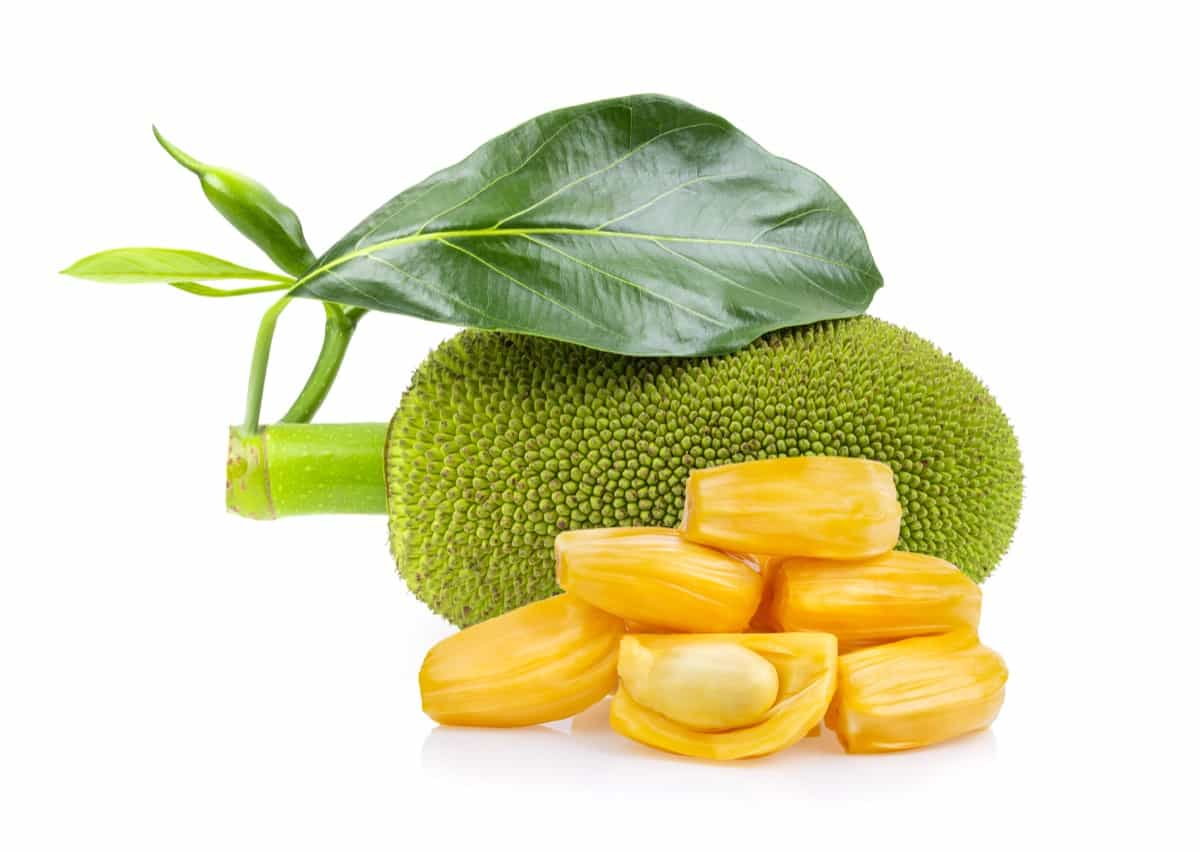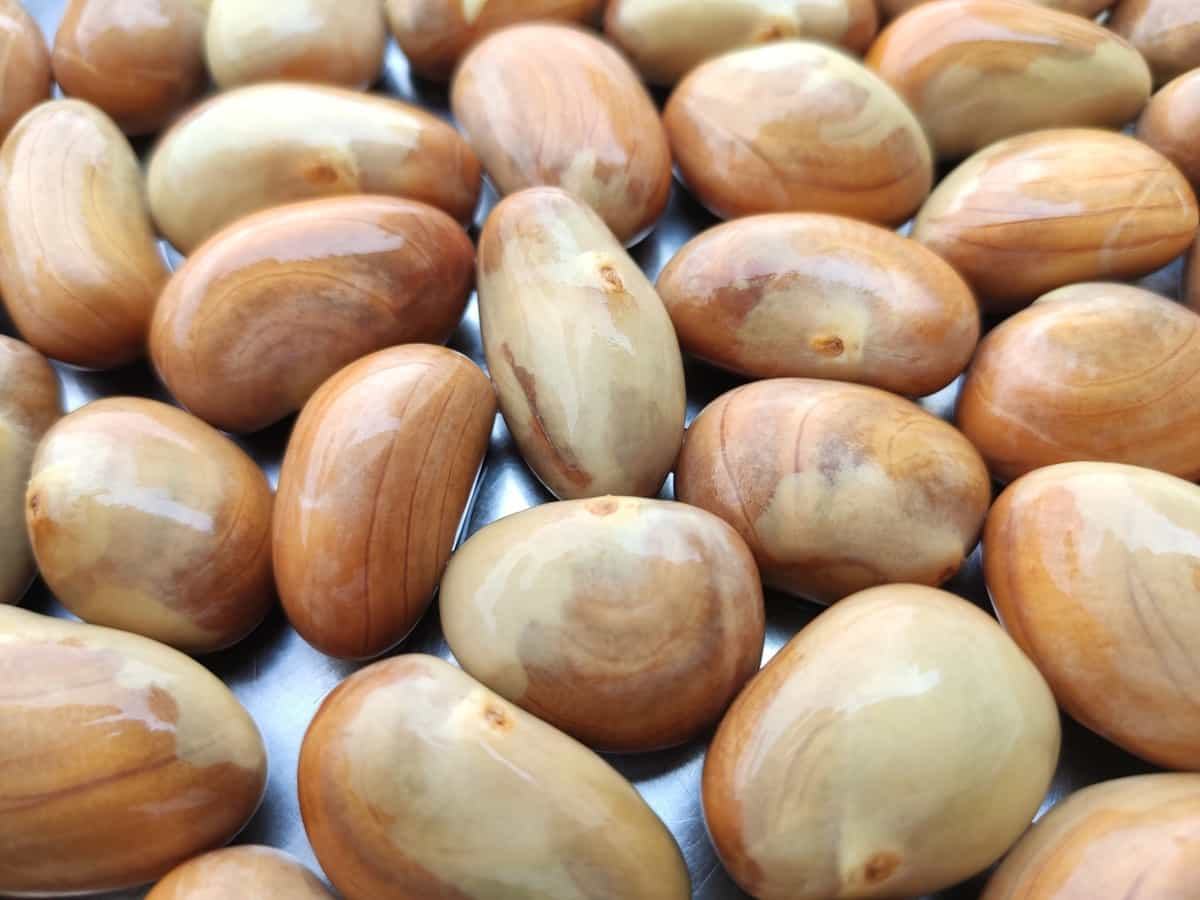Jackfruit, also known as Artocarpus heterophyllus, is a tropical fruit that belongs to the family Mulberry. Originating from tropical Asia, it has become popular worldwide for its enormous size and unique flavor. Jackfruit is delicious and an impressive addition to any garden or orchard.

How to Grow Jackfruit from Seed
Recommended Soil for Jackfruit Optimal Growth
Jackfruit trees prefer well-drained soil with a pH level between 6 and 7. Incorporating organic matter into the soil is also beneficial before planting. This helps improve drainage and adds valuable nutrients.
Jackfruit Seed Spacing
Proper spacing is essential for optimal growth and development when it comes to the propagation of Jackfruit from seed. Jackfruit trees are known to grow quite large, so it’s important to provide them with enough space to spread their roots and branches. Ideally, it would help if you allowed a distance of at least 20 feet between each Jackfruit tree. This ensures that they have enough room to grow without overcrowding each other.
Additionally, the spacing allows for better airflow and sunlight penetration, which is crucial for healthy tree development. How to plant Jackfruit? If you’re planting multiple Jackfruit trees in a row or in an orchard setting, ensure adequate space between the rows. A spacing of about 20-30 feet between rows will ensure easy access for maintenance and harvesting purposes.
Planting Jackfruit Seeds in Containers or Directly in the Ground
If you choose to plant your Jackfruit seeds in containers, it allows for greater control over soil quality and drainage. How to grow jackfruit from seeds indoors? Start by filling a large container with a well-draining potting mix mixed with organic compost. Ensure the container is 12 inches deep to accommodate the long taproot of young Jackfruit plants. Press one or two seeds into the soil, about an inch deep. Keep them moist but not waterlogged as they germinate.
On the other hand, if you have ample space, planting Jackfruit seeds directly in the ground is ideal. Select a sunny location that offers protection from strong winds. Prepare the site by loosening up and enriching the soil with organic matter like compost. Carefully place your young plant into the hole, ensuring that it sits at ground level without any roots exposed aboveground.
Time for Jackfruit Seed Germination
On average, it takes three to eight weeks for Jackfruit seeds to finally burst open and begin their journey toward becoming trees. During this period, it’s essential to provide optimal conditions for germination. The seeds require warmth and moisture to trigger the process.
In case you missed it: 1-Acre Jackfruit Cultivation Cost and Profit Analysis: Project Report and Economics

Selecting and Preparing Jackfruit Seeds for Planting
It is crucial to ensure the successful growth and development of your tree. When selecting seeds, choose mature ones that are fully ripe. Look for large, plump seeds with a brownish color. Avoid using small or shriveled seeds as they may have lower chances of germination. How to Sow Jackfruit Seed? Before planting, it is important to prepare the seeds properly. Start by soaking them in water overnight to help soften the seed coat and promote better germination. After soaking, wash off any remaining pulp from the seeds using clean water.
Next, you can scarify the seed coat by gently scratching or nicking it with a knife or sandpaper. To further enhance germination rates, some gardeners recommend pre-germinating Jackfruit seeds by wrapping them in moist paper towels or placing them in damp vermiculite for a few days before sowing. By carefully selecting and preparing your Jackfruit seeds before planting, you can give your trees a head starts toward healthy growth and abundant fruit production.
How Long to Grow Jackfruit from Seed?
Jackfruit trees are known for their relatively fast growth compared to other fruit-bearing trees. While most fruit trees can take years to reach maturity and produce harvestable fruits, Jackfruit trees are comparatively quick growers. After planting a Jackfruit seed, you can expect your tree to bear fruit in three to four years.
How Deep to Plant Jackfruit Seed: Jackfruit Growing Temperature
Planting three seeds about 1 inch (2.5 cm) deep in the soil is recommended for optimal growth. This depth allows the seeds to establish a strong root system while still being close enough to the surface for sprouting. These tropical fruits thrive in warm and humid climates, with Jackfruit growing temperatures between 21-32°C. It’s worth noting that Jackfruit trees are not frost-tolerant, so if you live in a colder region, you may need to grow them in containers or provide protective measures during winter.
Watering and Drainage for Jackfruit Seedlings
These young plants require consistent moisture, but overwatering can lead to problems. It’s important to strike the right balance. Aim for deep, thorough irrigation rather than frequent shallow watering when watering your Jackfruit seedlings. Provide enough water to reach at least 12-18 inches below the surface. Ensure your containers or planting beds have adequate holes to allow excess water to escape. If you notice any standing water after watering, adjust accordingly by reducing the amount or frequency of irrigation.
In case you missed it: Natural and Organic Ways to Treat Mango Tree Leaf Curl: Fix with Effective Home Remedies

Fertilization Techniques for Jackfruit Trees
Fertilization plays a crucial role in the growth and development of Jackfruit trees. To ensure healthy and productive trees, it’s important to provide them with the necessary nutrients. A balanced fertilizer containing nitrogen, phosphorus, and potassium is recommended. This will help promote Jackfruit production.
You can choose either organic or synthetic fertilizers based on your preference. It’s best to divide the total amount of fertilizer into several applications throughout the year rather than applying it all at once. This helps avoid nutrient overload and ensures a steady supply of nutrients for the tree.
Pruning and Training Jackfruit Trees
Regular pruning helps to shape the tree, control its size, and promote air circulation within the canopy. It also removes dead or diseased branches, reducing the risk of pests and diseases. When it comes to pruning Jackfruit trees, it’s best to start when they are young. Begin by removing any suckers that emerge from below ground level or low on the trunk.
These suckers can divert energy from the main trunk and hinder its development. Training Jackfruit trees involves tying down branches with soft ties or using stakes for support. This encourages lateral branching and helps create a more open framework for easier maintenance and harvesting.
Protecting Jackfruit Trees from Pests and Diseases
Fruit fly – These tiny insects lay their eggs in the immature fruits, leading to infestation. To combat this problem, you can use organic insecticides or set up traps with attractants like fermented fruit juices.
Mealybug – These small, white insects suck sap from leaves and stems, weakening the tree over time. Regular inspection of your Jackfruit tree’s foliage will help you spot any signs of infestation early on. You can manually remove them or use horticultural oils for control if detected.
Anthracnose – Fungal diseases like anthracnose can damage Jackfruit trees by causing leaf spots and rotting fruits. Good cultural practices like spacing out plants properly to improve air circulation and avoiding overhead irrigation can reduce the chances of fungal infections.
It is important to note that prevention plays a crucial role in protecting your Jackfruit tree from pests and diseases. Implementing good hygiene practices by regularly removing fallen leaves and debris will help eliminate potential breeding grounds for pests. Moreover, maintaining overall plant health through regular fertilization techniques will strengthen your tree’s natural defense mechanisms against diseases.
In case you missed it: Natural and Organic Ways to Treat Papaya Leaf Curl: Fix With Effective Home Remedies

Harvesting and Storing Jackfruits from Mature Trees
The main indicator for harvesting is the fruit should have a strong aroma, and its skin should turn from green to yellowish or brownish-green. It should feel slightly soft when pressed gently. To harvest the Jackfruit, use a sharp knife to cut the stem 2.5 cm above the fruit. Be careful not to damage the fruit during this process.
After harvesting, you can store unripe Jackfruits at room temperature until they ripen. Once ripe, the fruit can be stored in the refrigerator for up to one week. When enjoying your freshly harvested Jackfruit, you can savor its unique flavor and texture in numerous ways.
Conclusion
Growing Jackfruit in pots from seed requires patience, growing conditions, and proper care throughout the various stages of development. Jackfruit offers a delightful taste experience and an eco-friendly option for those looking towards sustainable living practices.
- Ultimate Guide to Ossabaw Island Hog: Breeding, Raising, Diet, and Care
- Ultimate Guide to Juliana Pig: Raising Facts, Size, Diet, Care, and Lifespan
- Raising Lleyn Sheep: Disadvantages, Price, Uses, Characteristics, and Care
- Ultimate Guide to Meishan Pig: Breed Facts, Breeding, Raising, and Care
- Ultimate Guide to Teacup Pigs: Raising, Diet, Lifespan, Cost, and Care
- Guide to Raising Poll Dorset Sheep: Facts, Profile, Characteristics, Uses, and Care
- Ultimate Guide to Bighorn Sheep: Characteristics, Diet, Lifespan, Breeding, and Lifecycle
- Ultimate Guide to Raising Katahdin Sheep: Farming Facts, Breed Profile, Uses, and Care
- Ultimate Guide to Raising Oreo Cows: Belted Galloways Farming Facts, Profile, Uses, and Care